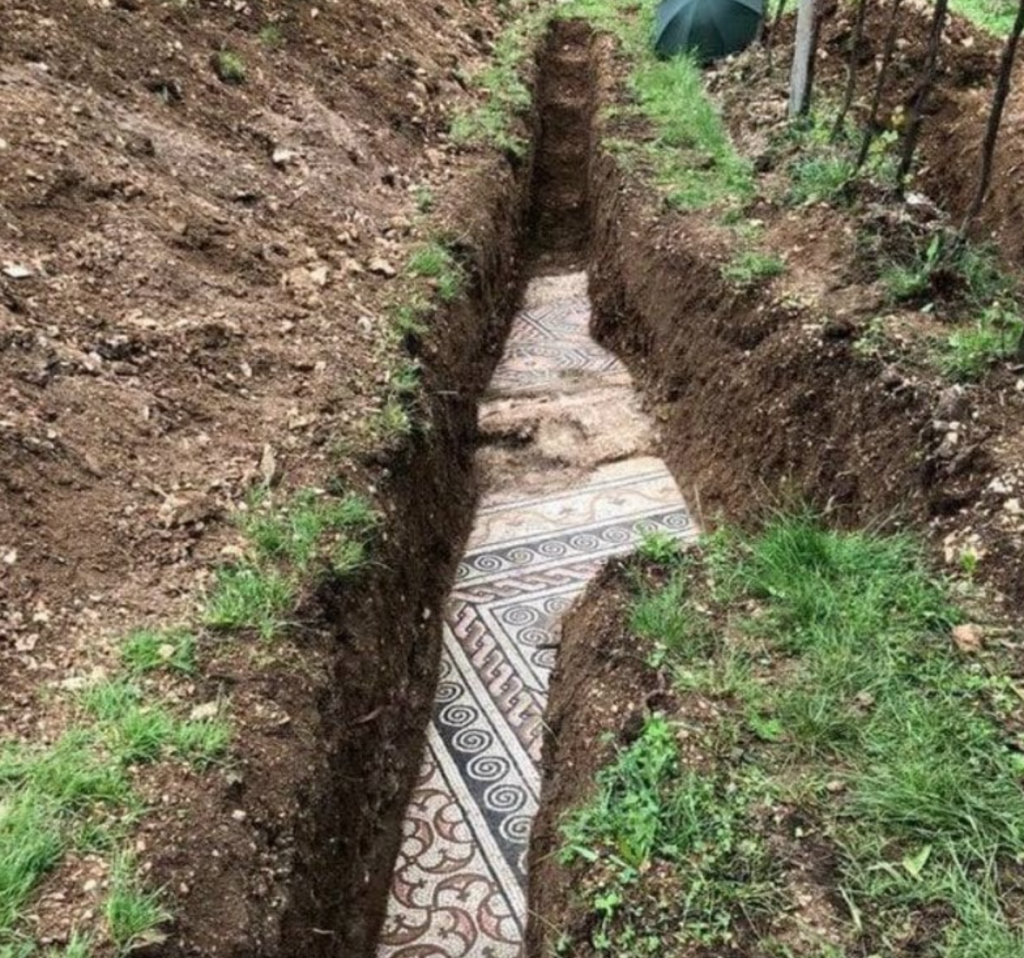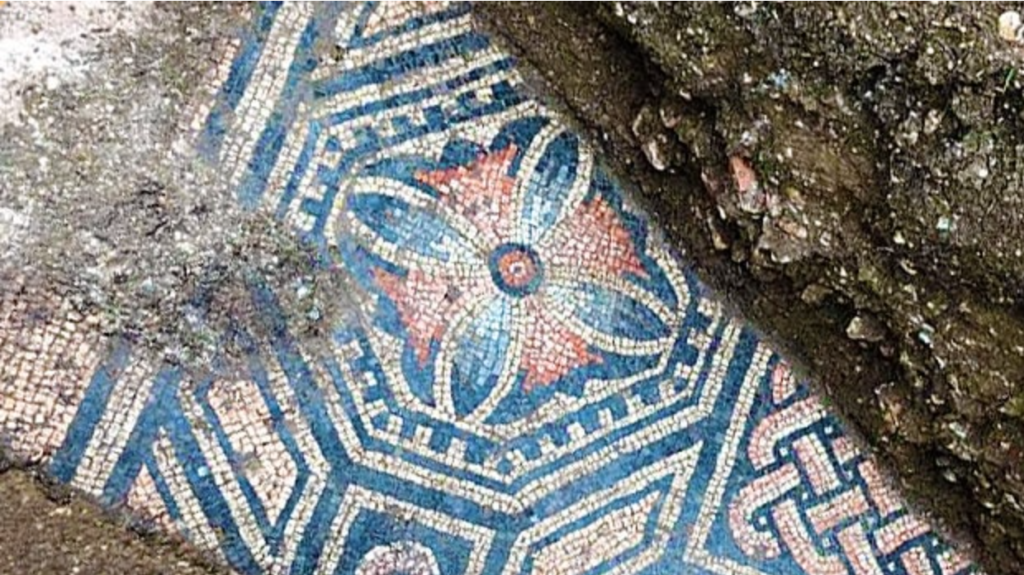Nestled beneath a farm in the rolling hills of northeastern Italy, an extraordinary Roman mosaic has been unearthed after lying hidden for over a century. This stunning piece of ancient artwork, discovered near Negrar di Valpolicella, close to Verona, has captured the attention of archaeologists and history enthusiasts worldwide. Dating back to the third century AD, the mosaic is not just a visual marvel but a testament to the exceptional craftsmanship and artistry of ancient Roman culture.
The Mosaic’s Journey from Obscurity to Discovery

For decades, the remains of a grand Roman villa in the Valpolicella region hinted at something magnificent lying below. Archaeologists, eager to uncover its secrets, had conducted numerous digs around the area. Yet, despite repeated efforts, the true beauty of the villa remained hidden beneath layers of earth—until recently.
Led by the Verona Superintendent of Archaeology, Fine Arts, and Landscape, a dedicated team of archaeologists finally struck gold. Their meticulous excavation revealed an intricate mosaic floor, preserved in remarkably pristine condition, offering an enchanting glimpse into a long-lost era of Roman life.
The Artistry of the Mosaic: A Testament to Roman Ingenuity
The mosaic itself is a breathtaking achievement of ancient engineering and art. Constructed from thousands of small tiles, known as tesserae, the floor is a kaleidoscope of geometric patterns and shapes, each tile meticulously placed to create an awe-inspiring design. These tesserae are crafted from marble and glass, a combination that catches the light and showcases the mosaic’s intricate details.
The sheer complexity of the design demonstrates the remarkable skill of the Roman artisans who created it. The craftsmanship involved in laying each tile by hand is a reminder of the patience and expertise required to complete such a work. Beneath the mosaic, archaeologists discovered multiple layers of mortar, suggesting that the floor had been repaired and maintained over the centuries. This careful preservation by the villa’s inhabitants underscores the importance of the mosaic to those who once lived there.
The Villa and Its Inhabitants: Uncovering Roman Life
As the excavation progresses, archaeologists hope to learn more about the Roman villa and the people who called it home. The villa’s size and the opulence of the mosaic indicate that it likely belonged to a wealthy Roman family. Such a household would have enjoyed a lifestyle of luxury, with rooms adorned with elaborate decorations and spaces designed for relaxation and entertainment.
By examining the villa and its surroundings, archaeologists aim to gain insights into the daily lives, customs, and social practices of ancient Romans. The region around Verona, known for its vineyards and fertile lands, was an ideal location for a Roman villa. Wealthy Romans often built these rural retreats to escape the hustle of city life, where they could indulge in the pleasures of country living.
The Historical Significance of the Roman Mosaic
The discovery of this mosaic is not just an archaeological triumph; it holds significant historical value as well. This mosaic sheds light on Roman artistry and architectural practices, contributing to our understanding of Roman society during the third century AD. The intricate designs suggest the influence of Roman ideals of beauty, geometry, and symmetry, revealing how these ideals permeated even the floor decorations of their homes.
Additionally, this find has broader implications for the study of Roman villas in northern Italy. It’s a rare opportunity to explore a site that has remained untouched for centuries, allowing archaeologists to collect data without the interference of previous excavations. The mosaic serves as a tangible connection to the past, offering new insights into the lifestyle, culture, and aesthetic preferences of ancient Romans.
Preserving the Mosaic for Future Generations
As breathtaking as this discovery is, it also presents challenges. The mosaic is delicate, and preserving it requires careful planning and collaboration. The Verona Superintendent of Archaeology, Fine Arts, and Landscape is working closely with local authorities and landowners to develop a plan for the mosaic’s conservation and potential display.
The team faces the task of balancing the preservation of the mosaic with making it accessible to the public. Steps such as covering the site with protective materials, limiting exposure to environmental factors, and potentially relocating the mosaic for display in a controlled environment are all being considered. By preserving this ancient artwork, archaeologists hope to make it available for future generations to study, admire, and appreciate.
The Discovery’s Broader Impact on Archaeology and Culture

The excavation of this Roman mosaic has reinvigorated interest in ancient Roman history and archaeology, particularly in Italy. Local communities, historians, and visitors alike are captivated by the mosaic’s beauty and the mystery of its origins. The discovery also emphasizes the value of archaeology as a means of preserving history, reminding us that beneath the surface of modern life, there are countless untold stories waiting to be uncovered.
This find has inspired renewed efforts to search for similar treasures, with archaeologists and researchers across the globe taking a fresh look at historical sites that might hold hidden gems of their own. In a way, the mosaic has rekindled an appreciation for the rich cultural heritage left by the Romans and the enduring influence they continue to exert on the world today.
Conclusion: A Timeless Piece of Roman Artistry
The discovery of the Roman mosaic beneath the farm in northeastern Italy is more than just a fortunate archaeological find—it’s a celebration of human ingenuity and the power of perseverance. For nearly a century, archaeologists remained dedicated to their search, their efforts rewarded with a window into the lives of the ancient Romans who once walked on these tiles.
This exquisite mosaic stands as a testament to the creativity, craftsmanship, and legacy of our ancestors, highlighting the beauty that endures even in the face of time. As we marvel at its intricate details, we’re reminded of the stories buried beneath our feet and the profound connection we share with those who came before us. This discovery not only deepens our understanding of ancient Rome but also encourages us to continue exploring and preserving the invaluable treasures of our past.


